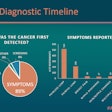
The rise of consumerism in healthcare is a growing trend, affecting everything from data ownership to patient-centered healthcare technology. The speed of change happening within the delivery of care is unmatched historically, forcing providers to continue to assess their systems and processes to ensure they maintain their competitive advantage.
Our physician-driven care delivery is being replaced by the notion of the patient as a consumer. Start-ups are directing their technology toward these patients/consumers, a trend that is requiring healthcare providers to become nimble in managing patient expectations and experiences. Fortunately, technology can help providers manage this transition.
A forerunner
Women's health is a radiology subspecialty that's a forerunner in the movement toward consumerism. Women still predominately make the family healthcare decisions and are taking greater control of their family's care.
 Jef Williams of Paragon Consulting Partners.
Jef Williams of Paragon Consulting Partners.In addition, mammography screening, per Mammography Quality Standards Act (MQSA) guidelines, does not require a referral in most cases. Allowing women to schedule their annual exams without the use of a primary care physician puts women squarely in the position of consumer.
The choice for screening is now a consumeristic landscape. While some entities maintain legacy models of screening based on patient referrals from physicians, it seems plausible that they too will be pressed to give up control of their patient's decisions and move to a patient-empowered, patient-centric approach to care and screening.
A consumer-minded marketplace will create the demand for a combination of capabilities and services for providers that will to some degree determine future success including volumes and revenue. Lessons learned from other disrupted industries indicate that women's health can expect some very specific market forces that will shift its practice.
To support this shift, women's health facilities must leverage technology to meet this demand. Consider that Blockbuster went from the Fortune 500 to bankrupt in less than 10 years due to lack of agility. Organizations should be laser-focused on providing the types of services on demand that consumer-driven care requires.
Four areas of demand that clinics, hospitals, and physician groups should be considering for success in the coming world of women's health consumerism are discussed below.
1. Superior service and experience
Finding ways to simplify registration and scheduling continues to push technology solutions to leverage web portals and integration into practice management and RIS/electronic health record (EHR) platforms to reduce the need to manage patients manually. Consumers expect their providers to make their experience easy. This means reduced wait times, ease of scheduling, expanded hours, and access to data.
2. Superior technology and imaging
As modalities such as 3D digital breast tomosynthesis (DBT) and ultrasound continue to emerge, patients will seek out providers that depend on these advancements to improve quality via reduced false positives and improved quality reporting. As studies continue to be published regarding the value of advanced imaging capabilities, entities should expect consumer education to affect decision criteria related to modalities and turnaround times. MQSA requires that letters be sent within 30 days of examination, and that is dependent upon receiving relevant priors. Ensuring your infrastructure accommodates tools that speed priors to the point of reading is critical to meeting this demand.
3. Superior quality and care
Quality care and reporting will become more transparent to the patient. This includes the ability for providers to make available to patients analytics on practice quality and referrals. This includes data portability that does not require patients to transport data to various sites via physical media.
4. Superior cost transparency
Patients eventually will demand that providers post true patient costs related to screening. Just as patients refuse to buy a prescription without knowing the cost and co-pay, so too will they expect the price of screening to be provided prior to the point of care. Due to changes in the insurance market, increased out-of-pocket expenses, and increases in co-pay, providers should expect that their patients will price-shop their services.
Technology as a facilitator
To meet the demands of the patient in a consumer-driven model, providers will need to ensure that their imaging platform can accommodate the shift in mindset. This includes taking into account the impact on image availability for both scheduled and unscheduled events within the screening clinic and hospital setting.
 Barbara Smith from Paragon.
Barbara Smith from Paragon.MQSA requires that original images (not copies) be provided when a patient changes facilities or needs images for follow-up. While this was most important when film was used, the manner in which digital studies are shared is still regulated by the U.S. Food and Drug Administration (FDA).
Regardless of whether patients are expecting portability across provider networks or just across local sites within a provider network, moving this data intelligently will both satisfy the patient expectation as well as the mammographers' workflow demands. Prefetching becomes a critical component to the infrastructure to ensure that images are routed via trigger by scheduling, arriving, or DICOM Modality Worklist events. Enabling this level of image management may require additional or peripheral technologies that integrate into existing platforms.
This requires that organizations prepare for a significant rise in complex image management. That includes data portability internally within the organization, which will require intelligent routing and compression -- especially as it relates to growing image sizes.
As patients choose clinics based on location, wait times, and equipment (modalities), this will drive demand for organizations to exercise greater capacity for image sharing across locations. This will be compounded as patients traverse provider networks based on app-type behavior (think Yelp) to reduce cost and inconvenience; data must be shared across provider networks that then must achieve patient matching rules to optimize the radiologist's reading experience and improve the quality of care.
Deploying appropriate tools built to achieve these complex routing and normalization requirements with a high degree of automation will separate lean and successful organizations from those using manual processes that are slower, riskier, and operationally more expensive.
Change is imminent. The rise of consumerism in women's health will require facilities to be agile, and this will, in turn, require organizations to conduct operational, clinical, and technical analyses to build their strategic road map to meet this new demand and achieve ongoing and future success.
Jef Williams is managing partner at Paragon Consulting Partners, a health IT advisory and consulting firm focused on having fun and doing right by its clients in healthcare -- and helping people spell their domain. More information is available at www.paragonconsultingpartners.com.
Barbara Smith is a partner at Paragon Consulting Partners, providing subject matter expertise and project management for radiology, mammography, and enterprise imaging projects of all shapes and sizes. Having worked in radiology for more than 20 years and IT consulting for almost 10 years, she brings relevant clinical and operational experience to health IT initiatives.
The comments and observations expressed are those of the authors and do not necessarily reflect the opinions of AuntMinnie.com.



















